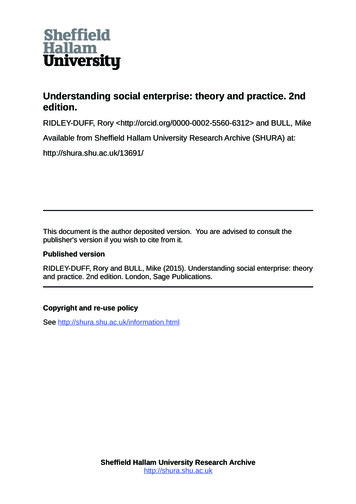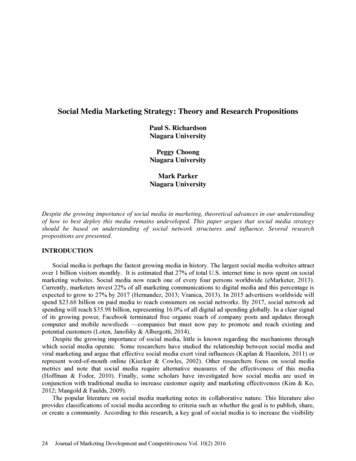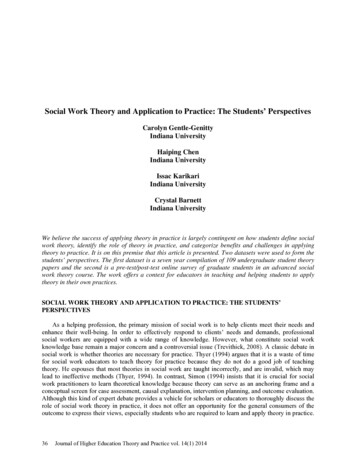
Transcription
Understanding social enterprise: theory and practice. 2ndedition.RIDLEY-DUFF, Rory http://orcid.org/0000-0002-5560-6312 and BULL, MikeAvailable from Sheffield Hallam University Research Archive (SHURA) at:http://shura.shu.ac.uk/13691/This document is the author deposited version. You are advised to consult thepublisher's version if you wish to cite from it.Published versionRIDLEY-DUFF, Rory and BULL, Mike (2015). Understanding social enterprise: theoryand practice. 2nd edition. London, Sage Publications.Copyright and re-use policySee http://shura.shu.ac.uk/information.htmlSheffield Hallam University Research Archivehttp://shura.shu.ac.uk
nadtsirnegdnUAILCOSNTERPRISEEandyroehT a c ti c ePrley-Du fdiRyrRolulBekiMdanSecondEdi tion00 Ridley-Duff Prelims.indd 39/22/2015 5:48:32 PM
SAGE Publications Ltd1 Oliver’s Yard55 City Road Rory Ridley-Duff and Mike Bull 2016First edition first published 2011; reprinted 2011, 2013This edition published 2016London EC1Y 1SPSAGE Publications Inc.2455 Teller RoadThousand Oaks, California 91320SAGE Publications India Pvt LtdApart from any fair dealing for the purposes of research orprivate study, or criticism or review, as permitted under the Copyright,Designs and Patents Act, 1988, this publication may be reproduced,stored or transmitted in any form, or by any means, only with the priorpermission in writing of the publishers, or in the case of reprographicreproduction, in accordance with the terms of licences issued by theCopyright Licensing Agency. Enquiries concerning reproduction outsidethose terms should be sent to the publishers.B 1/I 1 Mohan Cooperative Industrial AreaMathura RoadNew Delhi 110 044SAGE Publications Asia-Pacific Pte Ltd3 Church Street#10-04 Samsung HubSingapore 049483Editor: Matthew WatersEditorial assistant: Molly FarrellProduction editor: Sarah CookeCopyeditor: Gemma MarrenProofreader: Lynda WatsonIndexer: Martin HargreavesMarketing manager: Catherine SlinnCover design: Francis KenneyTypeset by: C&M Digitals (P) Ltd, Chennai, IndiaPrinted and bound in Great Britain by Ashford ColourPress LtdChapterChapterChapterChapterChapter4 Mike Bull, Rory Ridley-Duff and Pam Seanor5 Mike Bull, Pam Seanor and Rory Ridley-Duff9 Rory Ridley-Duff, Tracey Coule and Mike Bull10 Rory Ridley-Duff, Pam Seanor and Mike Bull12 Rory Ridley-Duff, Tracey Coule and Mike BullAll material on the accompanying website can be printed off andphotocopied by the purchaser/user of the book. The web material itselfmay not be reproduced in its entirety for use by others without priorwritten permission from SAGE. The web material may not be distributedor sold separately from the book without the prior written permission ofSAGE, except where materials are licenced by the authors using CreativeCommons. Should anyone wish to use the materials from the website forconference purposes, they would require separate permission from us.All material is Rory Ridley-Duff and Mike Bull 2016This book may contain links to both internal and external websites. Alllinks included were active at the time the book was published. SAGEdoes not operate these external websites and does not necessarilyendorse the views expressed within them. SAGE cannot takeresponsibility for the changing content or nature of linked sites, as thesesites are outside of our control and subject to change without ourknowledge. If you do find an inactive link to an external website, pleasetry to locate that website by using a search engine. SAGE will endeavourto update inactive or broken links when possible.Library of Congress Control Number: 2015937197British Library Cataloguing in Publication dataA catalogue record for this book is available fromthe British LibraryISBN 978-1-44629-552-6ISBN 978-1-44629-553-3 (pbk)At SAGE we take sustainability seriously. Most of our products are printed in the UK using FSC papers and boards.When we print overseas we ensure sustainable papers are used as measured by the Egmont grading system.We undertake an annual audit to monitor our sustainability.00 Ridley-Duff Prelims.indd 49/22/2015 5:48:32 PM
The Politics of SocialEnterprise3Learning objectivesIn this chapter we critically evaluate the global political context in which social enter‑prise has developed, and give further consideration to the influence of new publicmanagement and new public governance. Key to this chapter is understanding andacting on the tension created by the ascendancy of private sector practices in publicand third sector organisations, and the way actors in the social and solidarity economyhave responded to those tensions in innovative ways. By the end of this chapter youwill be able to: explain the concepts of globalisation and localisation explain the concepts of new public management and new public governance describe the impact of NPM on public–private–third sector relationships during andafter the 1980s critically evaluate how local government and organisations in the social economyresponded to NPM illustrate how social enterprise (internationally) is both an economic and politicalresponse.03 Ridley-Duff Ch 03.indd 889/22/2015 5:47:12 PM
The Politics of Social Enterprise89The key arguments that will be developedin this chapter are: Attempts to create global markets in goods and services are a recurrent cycle ineconomic history. Globalisation enables new forms of socially responsible businesses (SRBs), butalso triggers charitable trading activities (CTAs) and co-operative and mutualenterprises (CMEs) to limit/resist globalisation. The pursuit of NPM in the 1980s/1990s was a formative influence on thecurrent practice of spinning out social enterprises from the public sector. The social economy response to NPM involved the advancement of employeeownership and support for the solidarity economy.IntroductionIn this chapter, we adopt a perspective that is relatively rare in the study of socialenterprise. As we set out in Chapter 2, existing texts advance the idea that socialenterprise can take the form of CTAs or CMEs within the third sector. Alternatively,they are framed as a product of interactions between the private, state and third sectoractors to produce SRBs. In this chapter, we consider an alternative view that socialenterprise is a product of the tensions between attempts to privatise the delivery ofpublic services and the radical responses of local politicians and CMEs with socialistsympathies.We live at a time when the private economy (notionally the source of wealth) is themost subsidised sector of the economy. During the 2007–8 economic crisis, the helpgiven to private organisations in the UK and US dwarfed the help given to organisa‑tions in the social economy. The New Economics Foundation (nef) estimated thatthe UK’s ‘big four’ banks received subsidies to the value of 35 billion in 2012 inaddition to the ‘bail out’ investments made by the government (Prieg, 2012). This tookthe cumulative additional banking subsidy to 193 billion since 2007, six times greaterthan the value of all grants and donations to the charity sector, and nearly twice theturnover of the co‑operative and mutual sector. When considered alongside argumentsabout the creation of money (Positive Money, 2012), political claims about the‘efficiency’ of private markets look (at best) unsound and (at worst) compromised.The link to contemporary social enterprise is not immediately obvious, so initiallywe review the way economics developed, then changed, before and after the 1970s.03 Ridley-Duff Ch 03.indd 899/22/2015 5:47:12 PM
90Theoretical PerspectivesIn particular, we examine the roots, popularisation and impact of neo-liberalism, andthe effect this had on ‘left-of-centre’ entrepreneurship. In outline, the argument runsas follows:1. A breakdown in the post-war political consensus regarding macro-economic man‑agement and full employment coincided with the rise of the ‘new right’ in politics.2. The ‘new right’ advanced a set of principles that led to new public management asa way of legitimising SRBs in public administration.3. The ‘new left’ (a loose alliance of people holding anarchist, socialist and socialdemocratic beliefs) responded through regeneration activities based on CMEs.4. New Labour (in the UK) and social democratic parties across the EU adoptedsupply-side economics combined with commitments to social justice, equality andemployment protection as a third way.5. The three approaches to social enterprise emerged out of the tensions betweenliberal capitalist ideas embedded in NPM and the market socialism that respondedto it.6. By the 1990s, both SRBs and CMEs had prepared institutional challenges to ‘old’public, private and third sector development, and this triggered further CTAs in thevoluntary sector by the mid/late 2000s.To appreciate this perspective, it is first necessary to consider the history of globaleconomic systems that led up to the breakdown of the post-war consensus (beforeand after 1945, up to 1976). We then set out the central tenets of new public management (Hood, 1995) and the reactions of progressive liberal and socialist politicians(Chandler, 2008) who initially favoured SRBs and CMEs. Recent analysis links privatesector development to growing income inequalities, rates of suicide, communitybreakdown and endemic health issues, and this has fuelled interest in new models ofownership (Gates, 1998; Wilkinson and Pickett, 2010). We highlight the intersection ofSRBs and CMEs with public sector reform, while concurrently highlighting their grow‑ing popularity as a way to address inefficiencies in the private sector.Class exercise: Do you believe in the efficiencyof markets?A significant proportion of adults (both young and old) distrust politics and politicians. The Political Compass is an interesting project that enables a person to findout what their political values are, and how these compare to past and presentpolitical parties as well as figures from history. It shows how political parties (including the UK’s Labour, Liberal, Conservative and Green parties) have changed their03 Ridley-Duff Ch 03.indd 909/22/2015 5:47:13 PM
The Politics of Social Enterprise91values over time. Most have moved from anti‑authoritarian, left-leaning policiesto authoritarian right-wing policies. According to the Political Compass, mostGreen parties today occupy the space that Labour parties occupied in the 1970s.Labour parties are now more right-wing and authoritarian than the Conservative/Tory parties were in the 1970s.Activity: www.politicalcompass.org/1 Ask your students to take the Political Compass test before the seminar (or bringa tablet, smartphone or laptop to do it in class).2 Discuss the dimensions of the ‘compass’: the right–left dimension and theauthoritarian–libertarian dimension.3 Ask students to locate charitable trading activities, socially responsible businesses and co-operative and mutual enterprises on the political compass.After establishing students’ view of the political commitments of different types ofsocial enterprise, play this video to generate further discussion and reflection:Video: www.youtube.com/watch?v tskByXRGHjYThe rise of global capital andinternational marketsGray (1998) traces the concept of globalisation back to the rise of merchant capitalism,exemplified by the East India Company. In this venture, investors shared the risks ofinternational trade by jointly funding the establishment of trading routes to all partsof the globe to insulate individual ships and crews from local disputes. Today, theconcept of globalisation has taken on many shades of meaning, all linked to the tech‑nological, business and social institutions that make it possible to trade with peopleanywhere in the world. As Gray states:Globalisation is shorthand for the cultural changes that follow when societies becomelinked with, and in varying measures dependent on, world markets Behind all these‘meanings’ of globalization is a single underlying idea, which can be called de-localization:the uprooting of activities and relationships from local origins and cultures. It means thedisplacement of activities that until recently were local into networks of relationshipswhose reach is distant or worldwide. (2009: 57)As the scale of ventures increased, so a banking system developed to support them.In the mid-nineteenth century, a group of nations adopted the ‘gold standard’ tofacilitate international trade. The idea behind the gold standard was surprisingly simple.03 Ridley-Duff Ch 03.indd 919/22/2015 5:47:13 PM
92Theoretical PerspectivesNational governments backed their currencies with reserves of gold and agreed anexchange rate between their own local currency and international gold reserves. Thiswas expected to make it easier to trade internationally as national governments com‑mitted not only to using their gold reserves to settle international debts but also tosecuring the value of their local currencies with something of tangible value.Gray (2009) regards this period (from 1871 to 1914) as the first of two in recenthistory when international trade was dominated by institutions that used the rhetoricof free markets to secure advantage for industrialised economies. The first periodcame to an abrupt end when World War I broke out. As Block writes:The gold standard was intended to create an integrated global marketplace that reducedthe role of national units and national governments, but its consequences were exactlythe opposite. Polanyi shows that when it was widely adopted in the 1870s, it had theironic effect of intensifying the importance of the nation as a unified entity. Althoughmarket liberals dreamed of a pacified world in which the only international struggleswould be those of individuals and firms to outperform their competitors, their effortsto realize these dreams through the gold standard produced two horrific world wars.(2001: xxxi)Important to an understanding of social enterprise movements now, however, is asecond period during which international institutions again sought to create a globaleconomy, this time based on fluctuating currencies. According to Gray (2009), thesecond period occurred from the late 1970s (coinciding with rise to power of MargaretThatcher in the UK, Ronald Reagan in the US and Deng Xiaoping in China) until thecollapse of confidence in global capitalism in 2007–8. In 2008, governments again hadto provide financial and social security by taking over major parts of the bankingsystem. Polanyi’s words, first published in 1944, are extraordinarily prescient given thesituation that developed in 2008:The true nature of the international system under which we were living was not realizeduntil it failed. Hardly anyone understood the political function of the international mon‑etary system; the awful suddenness of the transformation took the world completely bysurprise Not even when the cataclysm was already upon them did their leaders seethat behind the collapse of the international system there stood a long developmentwithin the most advanced countries that made that system anachronistic; in other words,the failure of market economy itself still escaped them. (2001 [1944]: 21)Importantly, for contemporary debates on social enterprise, Polanyi argued that liberaleconomic theory fails to distinguish between ‘real’ and ‘fictitious’ commodities. Threeitems are singled out for discussion: labour, money and land (either in the form ofnatural resources or the properties we need to live). The assumptions of globalisationextend beyond the trade of tangible goods and services to the commodification ofmoney (through currency speculation), labour (by removing collective bargaining rightsand minimum wage protection) and land (through attaching prices to the natural03 Ridley-Duff Ch 03.indd 929/22/2015 5:47:13 PM
The Politics of Social Enterprise93resources required for living). Polanyi argues, in sharp contrast to Fukuyama’s (1995)advocacy of high-trust liberalism, that during historical periods in which money, labourand land are treated as commodities, commerce destroys social capital and the naturalenvironment. However, he stops short of condemning the market mechanism com‑pletely. So long as it trades in ‘real’ goods, it can be an important part of a mixedeconomy in which reciprocity and redistribution are also active principles (Hart, 2013).This clear departure from the followers of Marx meant that Polanyi’s work becameless popular amongst left-leaning policy makers. But with the rise of social enterprise,his argument that markets can play a limited role (providing they trade in ‘real’ goods),and work with democratic institutions and member-owned enterprises to generate anddistribute wealth, puts his contribution at the heart of social enterprise theory.(Nyssens, 2006)Gray explains why the commodification of money leads to banking crises:Transactions in foreign exchange markets have now reached the astonishing sum of over 50 times the level of world trade. Around 95 per cent of these transactions arespeculative in nature, many using complex new derivative financial instruments based onfutures and options. (2009: 57)As Erdal (2011) would later argue, nearly all transactions in global financial marketsproduce nothing of tangible value (i.e. a product or a service that has direct utilityvalue outside the financial sector). Vast quantities of labour (and money) are engagedin ‘casino capitalism’, producing ‘fictitious’ goods and services. If currency values bearlittle relation to the trading of ‘real’ goods, they will eventually destabilise markets andincrease economic volatility.However, the situation today is even more entrenched because of the way the com‑moditisation of money has been taken to extreme levels by fractional reserve banking.This allows the lending (again and again) of an amount of money before the principalhas been repaid. The only deduction necessary is the ‘fraction’ that regulators requirethe bank to hold in reserve to service their cash flow needs (Positive Money, 2012).Since the switch to digital transactions through online bank accounts and credit/debitcards, banks have started to lend digital money (without anything to underpin itsvalue). The Positive Money movement estimates that 97 per cent of the money nowcirculating is created ‘out of thin air’ by private banks (not governments), bears littlerelationship to the ‘real’ goods and services in the economy, and increases the volumeof money traded as a commodity.These critiques have a powerful salience today. They highlight how ‘fictitious’ mar‑kets in labour, money and land are implicated in the failure of market institutions andstate bodies. In the next section, we examine in more detail the doctrines that led tothis commodification and how this changed the balance of power between those withmoney (banks and corporations) and those with political power (governments andsocial movements).03 Ridley-Duff Ch 03.indd 939/22/2015 5:47:13 PM
94Theoretical PerspectivesThe end of the post-war consensusPolanyi’s hopes for a more mixed economy (under state influence) were advancedinitially through the application of Keynesian economics. This supported an expan‑sionary policy with the state actively regulating aspects of the economy. The maincritique of Keynes came from the Chicago School of economists who argued thatgovernment intervention is the source of the boom and bust cycle by contributing toinflationary policies that make recessions worse (Sloman and Sutcliffe, 2001: 598).They argued that government should limit itself to regulating the supply of money.These views, associated strongly with Milton Friedman (1968), came to be seen assupply-side economics. The goal was to regulate inflation and employment by matchingthe supply of money (monetarism) to the productive capacity of the economy.Class exercise: Positive moneyIn the YouTube video at the link below, the Positive Money movement explains howmoney is created and who benefits from its creation. Watch (the first 10 minutes of)this video and consider the following questions:1 In a modern economy, who controls the creation of money?2 Who profits from the creation of money?3 What issues arise in using this system to regulate the supply of money to theeconomy?4 How could the right to create money be changed to finance the public (orcommunity) sectors?Video: www.youtube.com/watch?v d3mfkD6Ky5oHood (1995) outlines a deep shift in both accounting and management practicesthat reflected the supply-side arguments of monetarism, leading to a diminishingrole for the state as a manager of public enterprises, and ending the state’s role asthe employer of choice in public services and utilities. Gradually, politiciansaccepted arguments to withdraw from direct provision and either use taxes to com‑mission services from third parties, or privatise service delivery. Hood argues thatthis spread gradually, but not completely, across OECD countries. It took rootquickly in the UK, Canada, New Zealand, Australia and Sweden, partially in France,Austria, Norway, Ireland and Finland, but not at all in Japan, Greece, Spain andTurkey (until much later).03 Ridley-Duff Ch 03.indd 949/22/2015 5:47:13 PM
The Politics of Social Enterprise95Klein (2007), however, argues that Friedman’s advocacy of monetarism wasadvanced by capitalising on disasters – both accidental and manufactured – ratherthan its intrinsic merits. She argues that the private sector spread New Right thinkingthrough media empires that were not controlled by the state (Chomsky and Herman,1988). It was not until the internet age that counter-arguments could be spread rapidlythrough new democratised forms of communication and publishing.A persuasive (and amusing) critique of the effects of new right thinking occurs inthe work of Harvey (2010). He supports Klein’s contention that crises are an importantaspect of the capitalist system because holders of larger amounts of capital secure thebenefits of a fall in market values (through their greater capacity to absorb losses andbuy up assets from bankruptcies and insolvencies). Harvey questions whether thosefavouring a capitalist economy have any satisfactory solution to crises, and postulatesthat capitalists are shifting the crises around geographically rather than confronting orsolving inherent weaknesses of the system. If we consider the Asian crisis in 1997, theSouth American crisis in 2001, the UK/US crisis in 2007–8, and then the EU sovereigndebt crises in 2012, Harvey’s argument looks credible.Class exercise: David Harvey’s ‘The crisesof capitalism’In this RSA animation (link below), David Harvey examines how the 2007–8 crisiscame about. Following Klein, he sees method in the madness of crises, and callsfor an anti-capitalist response. Consider the geo-politics that Harvey describes andthen consider the emergence of social enterprise. Do you think that social enterprises are emerging today as an anti-capitalist response? Or are social enterprises anew part of the existing capitalist system?1 Which of the explanations of the 2007–8 crisis provided by David Harvey do youfind most persuasive?2 Will CTAs, SRBs and CMEs be able to form an ‘anti-capitalist’ movement?3 If yes, what makes these organisations anti-capitalist?Video: www.youtube.com/watch?v qOP2V np2c0The effects of new public managementChandler (2008) views NPM as an ideological shift towards new right thinking in themanagement of public services, leading to arguments for the creation of SRBs and03 Ridley-Duff Ch 03.indd 959/22/2015 5:47:13 PM
Theoretical Perspectives96contracts for CTAs. In the short term, this is manifest in programmes to privatise utilitycompanies (gas, telecoms, water and electricity). In the longer term, and perhaps moresignificantly, NPM manifests itself in ‘doctrines’ that replace collaborative approachesbased on political and professional judgement with target-driven approaches based onmanagerial control. Hood (1995) set out a number of ideological shifts as well as theiroperational and accounting implications. In Table 3.1, we examine one of the doctrinesto understand the nature of the shifts that took place.Table 3.1One of the seven doctrines of new public ion ofpublic sector bodiesinto corporatised unitsorganised to deliverdiscrete products andservicesMakes units manageable;focuses blame for failure;splits commissioning andproduction to reduce wasteBelief in uniform, inclusivepublic sector; belief incollaborative approachesto public service ionsErosion of single service More cost centres;employment; arm’smove to activity-basedlength management tocosting (ABC)separate commissioningand provision of services;devolved budgetingSource: Hood (1995), Table 1 ElsevierThe other doctrines included: more contract-based, competitive tendering with internalmarkets and fixed-term contracts; a greater emphasis on private sector styles of man‑agement; more stress on discipline and frugality in use of resources; more emphasis onvisible hands-on top management; formalised standards and measures of performanceand success; and a greater emphasis on output controls. Of note here is the move awayfrom long-term employment, collaborative (and uniform) service provision towardsdecentralised units that compete both with each other and new kinds of serviceprovider (charities, voluntary organisations, employee mutuals, private corporations).Case 3.1 illustrates how practices associated with NPM influenced public sectorreform, and can be linked to the potential development of both CMEs and SRBs. TheNational Health Service in the UK has been divided into commissioning and pro‑vider bodies to create a quasi-market. This was encouraged through a ‘right to request’policy that allows staff to externalise existing services into discrete social enterprises.Case 3.1The ‘right to request’ in the UK National Health ServiceThe contemporary expression of NPM in the form of social enterprise can befound in the National Health Service (NHS) of the UK. In November 2008, the03 Ridley-Duff Ch 03.indd 969/22/2015 5:47:13 PM
The Politics of Social Enterprise97NHS published Social Enterprise – Making a Difference: A Guide to the Right toRequest. The ‘right to request’ allows any health professional to put a ‘businesscase’ to its primary care trust board to set up a social enterprise. The presentation of social enterprise to health professionals states that it is ‘fundamentallyabout business approaches to achieving public benefit’ (NHS, 2008: 6). Thefocus on innovation, reorganisation into business units providing discrete services, and outcome-driven management is evident in the Chief Health ProfessionsOfficer’s statement:Social enterprise will not be the answer for everyone, but allied health professionals have a long history of providing innovative services in a variety ofsectors, settings and throughout care pathways and patient journeys.Consequently, allied health professionals are in an excellent position to takeadvantage of the ‘right to request’. This may be for a particular profession,such as podiatry or physiotherapy, a specialism such as musculoskeletalphysiotherapy, a particular care group, or a combination of these. What ismost important though is that this is about developing a service that willmeet local need and maximise your potential to innovate and ultimatelyimprove outcomes for patients, clients and families, whilst remaining part ofthe NHS family. (NHS, 2008: 3)Interestingly, Hood finds it difficult to distinguish between a privatisation agenda anda social democratic reaction to NPM that uses social enterprise to limit the influenceof the private sector:It might be argued that NPM has been adopted in some contexts to ward off the NewRight agenda for privatisation and in other countries as the first step towards realizingthat agenda. Much of NPM is built on the idea (or ideology) of homeostatic control; thatis, the clarification of goals and missions in advance, and then building the accountabil‑ity systems in relation to those pre-set goals. (1995: 107)Concern that ‘non-profits’ are being sucked into a ‘contracting culture’ (Dart,2004) is based on this analysis of the deep shift in management thought and anacceptance of business norms based on commercial contracts. Certainly, there arenew providers who adopt a variety of hybrid models, including SRBs that mixemployee ownership and private investment (for an example, see www.circlepartnership.co.uk). This reflects a change in public policy to take away decisionmaking from large strategic health authorities and give it to smaller clinicalcommissioning groups.03 Ridley-Duff Ch 03.indd 979/22/2015 5:47:13 PM
98Theoretical PerspectivesHowever, contracts typically embed new forms of management control and govern‑ance that are considerably less ‘empowering’ than the rhetoric accompanying them(Pratchett and Wingfield, 1996; Curtis, 2008). The increased formalisation (visioning,mission statements, audit), and the outcome-driven character of measurement (targets,service-level agreements and competition), represent a cultural shift to a legal-rationalsociety based on homeostatic controls, rooted in cause–effect assumptions derivedfrom positivist research. There are good reasons to question the efficacy of this.Hebson et al. (2003) found that the replacement of bureaucracy with contracting‘partners’ decreases opportunities for the collaborative decision-making that can dealwith ‘complexity’ (Stacey, 2007). Transparency decreases and the use of legal remediesincreases as service commissioners adapt to their monitoring function, and use theirpower to adjust rewards (i.e. pay) in line with service-level agreements. Where provid‑ers find they cannot meet these agreements (either through their own over-estimationof their capacity, or through unrealistic targ
Chapter 5 Mike Bull, Pam Seanor and Rory Ridley-Duff Chapter 9 Rory Ridley-Duff, Tracey Coule and Mike Bull Chapter 10 Rory Ridley-Duff, Pam Seanor and Mike Bull Chapter 12 Rory Ridley-Duff, Tracey Coule and Mike Bull All material on the accompanying website can be printed off and photoc











